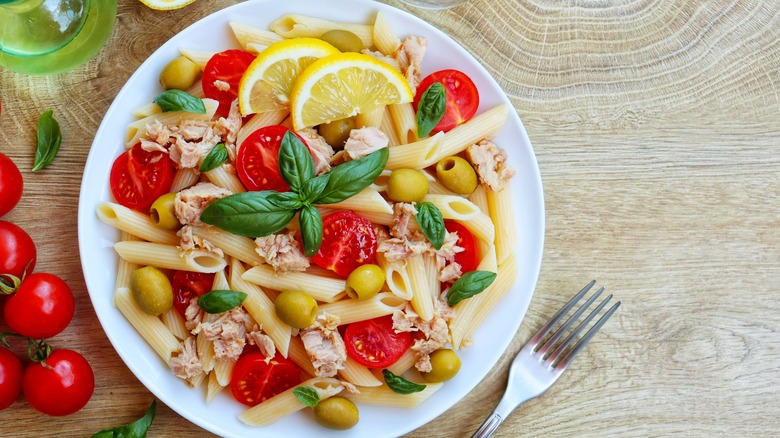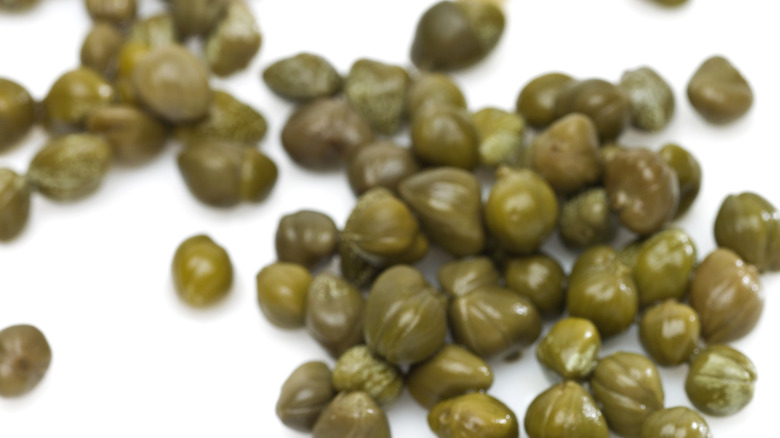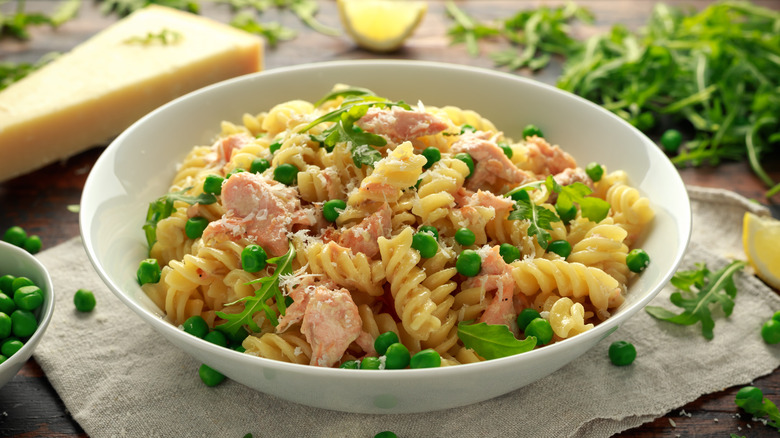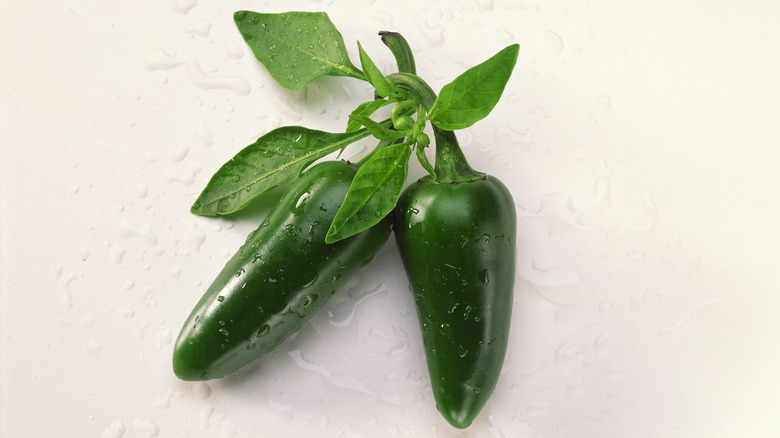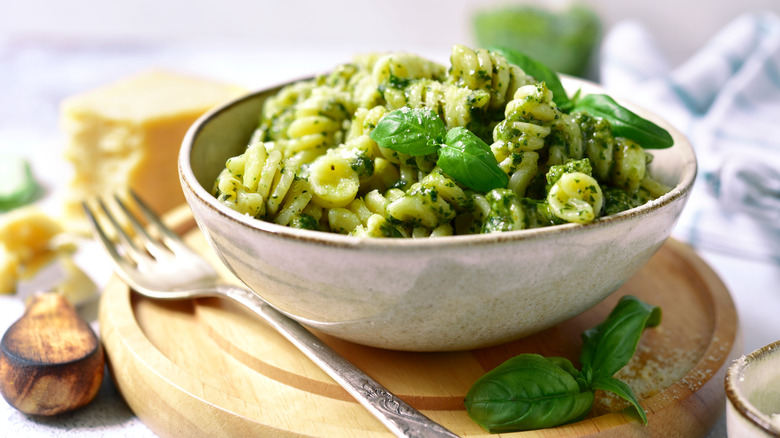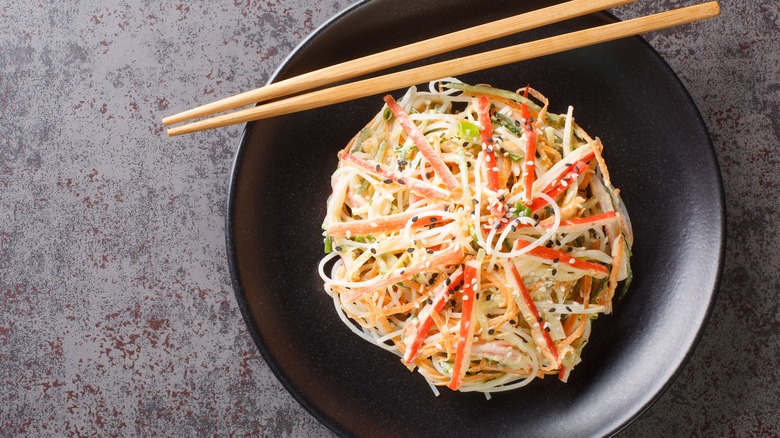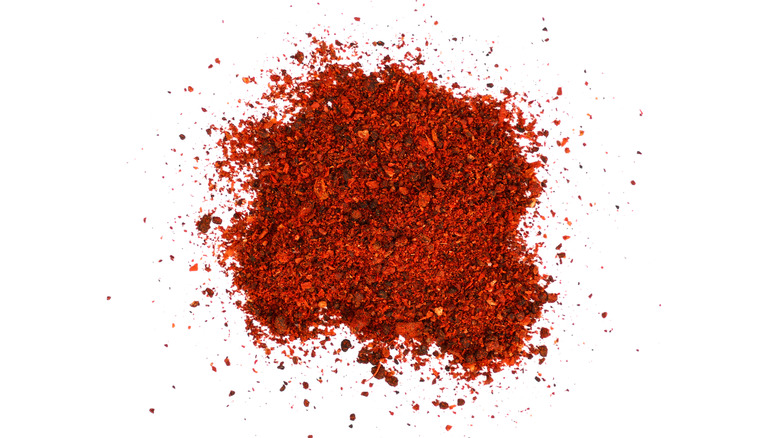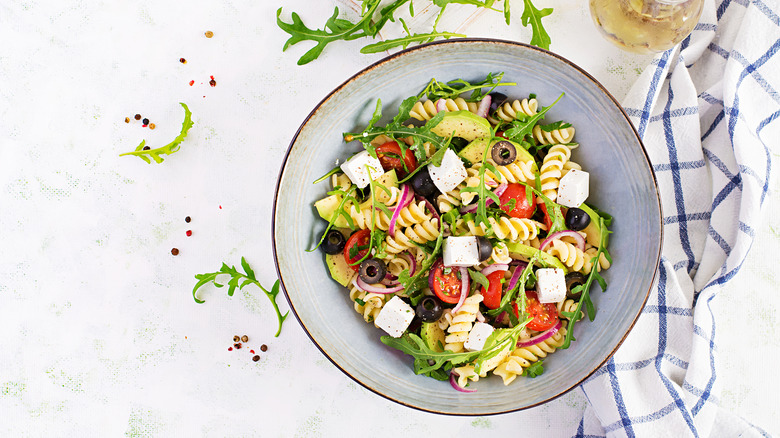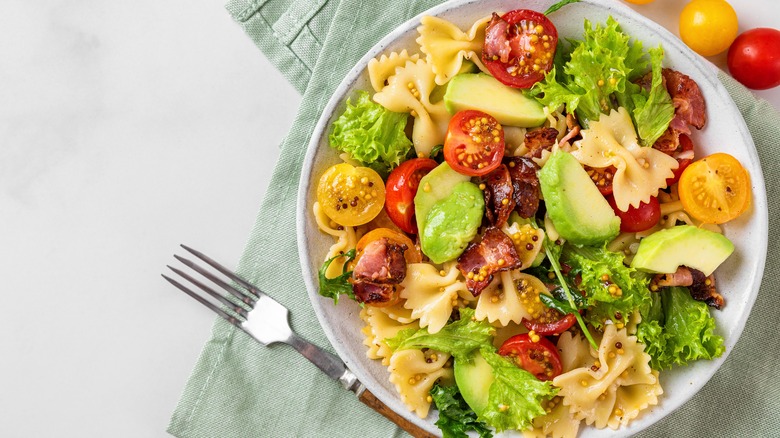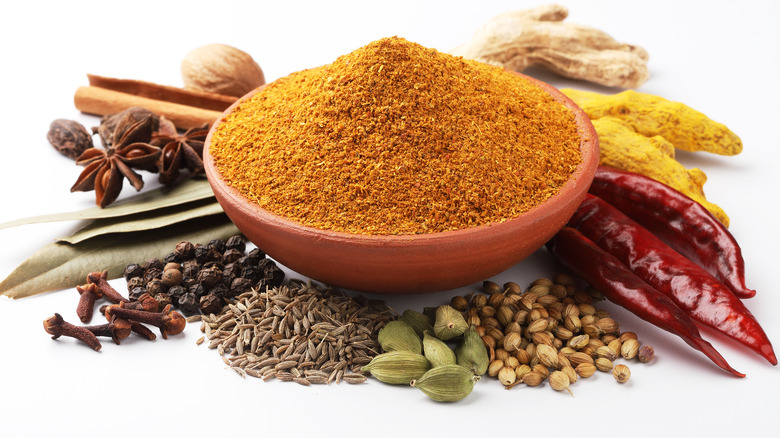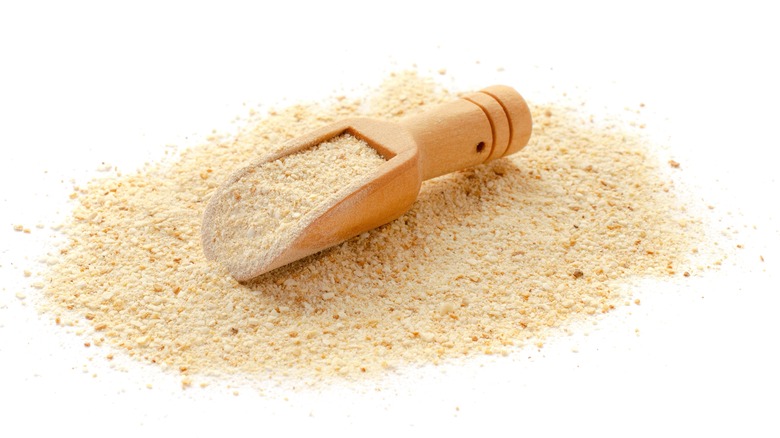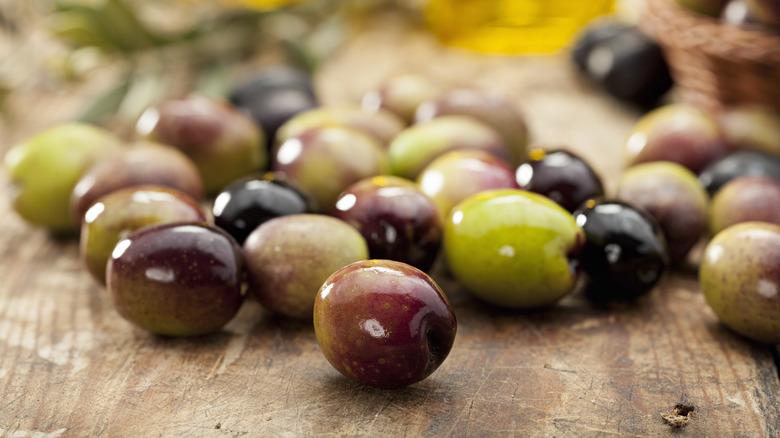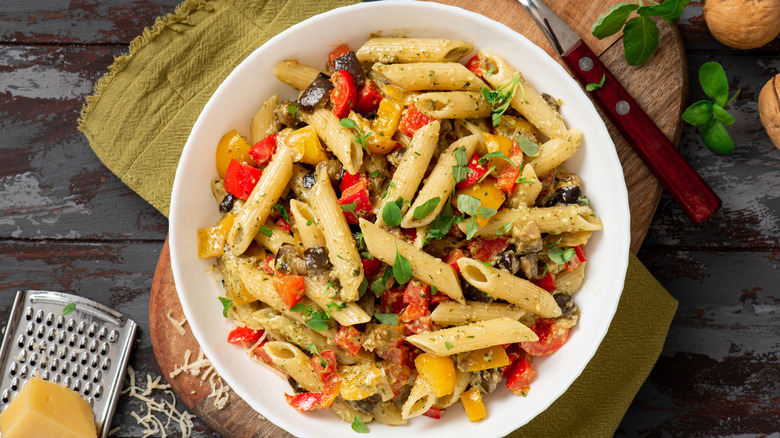12 Secret Ingredients You Should Be Using In Your Pasta Salad
"I'll pass on the pasta salad," said no one ever. Yet we've all had pasta salad that wasn't quite there. Maybe it was watery, or perhaps just uninspired. Maybe it tastes like last night's leftovers, which it may be. There's no reason to let that happen to your pasta salad. It's easy to fall in love with a favorite you've been making for years, especially one that's usually an accompaniment to traditional foods like hot dogs or barbecued steaks. Yet there's no reason to stick to a traditional recipe when making pasta salad. Just one or two secret ingredients can do the trick.
Start with the kind of noodles you use. If you always reach for the same old macaroni salad, stop. How would that salad taste if you substituted rotini, fusilli, or "bowtie" farfalle for macaroni? What if you chose orzo instead of macaroni? Each shape suggests a variation you might not have considered if you stuck to the same pasta. And don't worry about overcooking those noodles. Despite what you've heard, overcooking noodles will actually result in a better pasta salad. One of the down sides of pasta salad is time — you have to boil the noodles, wait for them to cool, and then chill them. The sheet-pan hack will cut time by quickly cooling the pasta so you can get to the fun part — eating. Here are some secret additions to take your next pasta salad from average to inspired.
Capers
What about dill pickles? They're a must for pasta salad, aren't they? Not necessarily. For once, forget the dill pickles and add a lemony Mediterranean accent with capers. They will make your pasta salad taste like a celebration. There's something about capers that immediately elevate any dish, from basic tuna casserole to a creamy piccata. Although they appear in numerous main dishes, they are an excellent choice for lunch – these little jewels are great with pasta dishes, and salads are no exception.
If you still want the dill flavor, chop up some fresh dillweed or add some pickle juice. You can also make a cooked white wine sauce using capers, garlic, and lemon juice. Adding capers to a pasta salad is taking that extra step. It's about showcasing your versatility. Despite their intense flavor, capers are more subtle than pickles because of their size; you get just a bite of the tart, puckery flavor as it blends into the creamier aspect of the salad.
Seafood
Seafood and pasta seem to go together. You'll find them in clam linguine, crab pappardelle, and lobster mac and cheese. Add seafood to your pasta salad, and you will elevate it to main-dish status, which takes the pressure off dinner prep. If you're worried that you might overcook your pasta, don't. Pasta salad is very forgiving, and undercooked pasta won't taste undercooked once you toss it with vegetables and salad dressing. Speaking of dressing, almost any type works with a seafood pasta salad. Just consider the taste of the seafood when you're deciding on how to dress it. Do you want something with a sour cream base? Creamy cheese? Would you better bring out the seafood's flavor if you combined mayo and Old Bay seasoning? What about a cooked sauce or an olive or avocado oil as a base for dressing?
Shellfish is a natural for pasta salads, but many types of fish make excellent salads. Pasta salad becomes a main dish with flakes of still-warm salmon in a salmon and arugula pasta salad. Start there, and you'll soon find many ways to incorporate freshly cooked or leftover seafood into your pasta salads.
Green chiles
These dynamic additions are often left out of the recipes for pasta salad. Maybe it's because they usually show up in dishes that require bold flavors. Or perhaps the first thing many people imagine when they think of green chiles is stuffed, breaded, and fried in chile rellenos, the popular dish lots of Mexican restaurants serve. Chiles come in handy to add a layer of heat to soups, sandwiches, and stews. You can also create a simple main dish quesadilla by adding chilies and cheese to a tortilla and heating it to melt the cheese. Keep some cans handy to increase the heat on your favorite recipes, including pasta salad. Fire-roasted green chiles are easy to store and use, and they are mild enough to add zing without causing anyone to reach for the water.
The spicy kick is the perfect complement to the salad pasta of your choice, but you don't have to get fancy with it. Consider that good old standby macaroni salad you've made for years. What if you transformed that humble creation into a green chile-cheddar macaroni salad? Add a can of green chiles, chopped onion, and shredded cheddar. After that, you can play with the garnishes — thinly sliced radishes, crumbled bacon, or seasoned breadcrumbs.
Pesto
You won't need mayo when you add this blend of pine nuts, basil, and the nut oil of your choice. We use pesto for any number of culinary tasks. That combination of olive oil, garlic, basil, pine nuts, and parmesan makes a perfect base for avocado toast or paninis. It's frequently used in warm pasta dishes — but it's also an excellent ingredient for cold pasta salads. That's probably because its texture and flavor are compatible with the relatively bland pasta. And the scent of garlicky basil will make any kitchen smell like a restaurant. If you're in a hurry, and the dinner hour is approaching, pesto is all you need. It's a go-to ingredient for pasta salads as well. If you add only pesto to freshly cooked bowtie pasta, you'll have a salad that requires little if any garnishes. If you want to go fancy, a pesto pasta salad will lend itself to numerous ingredients. Seafood is a natural. So are mozzarella and cherry tomatoes. Everyone loves grilled corn. Make extra and you can create a grilled corn pesto salad.
Pesto is a perfect addition to vegetarian or vegan pasta salads. It provides richness, and flavor, regardless of whether you add many vegetables or just a few. Remember that pesto doesn't have to be basil. Experiment with those made with cilantro, mint, and sun-dried tomatoes, or add roasted red peppers or black olives to prepared pesto you've made or bought. Whirling up pesto in the blender takes just a little time. You can always buy it prepared if you must.
Nut butter
When was the last time you used nut butter in a salad? Yet peanut or almond butter complements many Asian-themed salads. Slender carrot matchsticks, thinly sliced radishes, cucumbers, and scallions will give you a head start in helping to create a unique and delicious pasta salad. Add meat or seafood, or stay with vegetables. The salad dressing will be the star of this show. It should be creamy, sweet, hot, and tart. Each taste should reveal some new layer of flavor. Combine your nut butter with soy sauce, ginger, rice vinegar, and Sriracha as this spicy vegan dragon noodle salad does. Taste until the flavors work for you.
Nut butter-based dressings are thick and creamy, so you should consider that when you pick your pasta salad noodles. In addition to your usual choices, experiment with soba and rice noodles. Most pasta salads do well with curly noodles so the dressing can cling better and the flavor will be more uniform. You don't have to worry about that with nut butter. These dressings are made to cling to all they touch, so your choice of noodles is endless.
Tomato powder
You've used fresh tomatoes, canned, and frozen tomatoes, and now there's another smart way to blend in this versatile food. Tomato powder is a secret ingredient that will totally elevate your pasta salad — and it's super easy to use.
Stir a mixture of tomato powder and water into your pasta after it boils, just enough to flavor it. Then, add your choice of vegetables — maybe thinly sliced broccoli or spinach — and parmesan or mozzarella cheese. Other additions include bacon, avocado, and fresh tomatoes for a BLT vibe, or fold in a creamy ranch dressing for pure decadence. You can also dilute tomato powder with a little water, broth, or wine before you add it. Or whisk it into your oil or mayo. Finally, you can simply sprinkle tomato powder directly onto your pasta salad — trust us, a few shakes and you'll fall in love with the savory goodness it adds to your dish.
Feta cheese
When choosing cheese for a pasta salad, you can't go wrong. And when you're choosing cheese, be sure to try feta. This addition adds a Greek flavor to the simplest pasta salad. Few ingredients pack as much flavor into a single bite as feta cheese. Feta is a perfect addition to pasta salad; its salty taste and creamy, crumbly texture highlight both vegetables and pasta. Fresh tomatoes and basil call out for feta. Add olives, and you'll have a Mediterranean feast. Feta also pairs with traditional macaroni salad, waking up those basic ingredients with its tangy flavor. Almost every vegetable you add to a salad is enhanced by feta. Almost every spice enhances it.
With feta, it's almost as if you have two dressings. It pairs well with oil and vinegar dressing, French, dijon, and creamy dressing. Then comes your pasta choice. Curly pasta like rotini and fusilli are great because they will hang onto your dressing, and your feta chunks will stand out among your other ingredients.
Avocado
Avocados win just about any popularity contest. A ripe avocado can bring a boring salad to life. It will transform an already-great salad into a masterpiece. Adding an avocado to pasta salad does three things. First, is the color; that pale green beauty against a bowtie or another intriguing pasta shape announces that this isn't just any salad. Second, is the flavor. An avocado is versatile. It shines in chili dishes. It stands out mashed and seasoned in guacamole. It's delicious in a vegetarian or vegan creation or with the meat or seafood of your choice. With just a few additions, this transformative ingredient will elevate plain old pasta to a Cobb salad classic. Finally, is its texture. An avocado is creamy, delicate, yet substantial.
When choosing an avocado, go by feel and not by color. If it's firm to the touch but yields when you press it gently, it's ready to eat. In addition to being the best friend a pasta salad ever had, an avocado can also be the base for a salad dressing. And you can use leftover guacamole as a dressing for pasta salad.
Curry powder
Curry is made from a combination of spices — turmeric, ginger, cumin, black pepper, and sometimes garlic and cinnamon. While curry sauce can add a spicy, comforting warmth to lamb dishes and crab dishes with catfish, curry powder is also a perfect addition to pasta salads. Mix it into the mayo to add depth to your salad. Add olive oil, balsamic vinegar, and sugar for a vinaigrette worthy of your best pasta creation. Bring out that curry flavor by tossing in some chopped apples and nuts. The apple juice will blend with the dressing as the apple absorbs the curry's taste.
Curry powder is a favorite option for vegans and vegetarians, and it stands out in a vegetarian pasta salad. No one is going to call a curried vegetable salad boring. Combine finely chopped cucumbers, carrots, and red onions. Or opt for cruciferous broccoli or cauliflower. Add chutney for an additional flavor boost.
Breadcrumbs
Are you up to gilding the proverbial lily with even more carbs? Reach for the breadcrumbs. Sprinkle seasoned breadcrumbs over that pasta salad, and you bring instant crunch. You also add a hint of the flavor to come. Breadcrumbs are more than just a topping. They can be one of the standout ingredients in the salad. Along with flavor, they add texture — a Mediterranean salad of sundried tomatoes and mixed olives, for instance, will benefit from coarse, Italian-flavored crumbs. You'll get a different effect if you combine rye bread crumbs and diced corn beef in the salad.
Breadcrumbs act the same as croutons do in a salad; they're just smaller. Season them the way you would croutons. Herbed crumbs are among the easiest to make — chop fresh or packaged herbs into the crumbs and add salt. Try French bread and tarragon or sourdough and basil or sage.
Grilled olives
You can't go wrong with olives in a pasta salad. From kalamata to niçoise to those green "martini olives" picholine, olives will add subtle yet powerful flavor to any pasta salad. Choose glossy black, speckled, that traditional "olive" color, or a mixture. Olives excel in visual appeal and flavor. Yet we tend to take olives for granted. They're in our sandwiches, and on pizzas, and although they have been a popular salad addition for years, most cooks add them and forget them. One way to increase their impact on your pasta salad is to grill them. Grilled olives are usually served as appetizers, yet they are even better when combined with pasta in a salad where they can show off. Mediterranean salads are a natural home for grilled olives. Or try a pasta salad composed of mixed olives and spiked with a lemony dressing. The grilled olives will hold their own and complement the other ingredients.
You probably don't have grilled olives in your fridge right now. If not, remember to grill extra ones the next time you barbecue. They cook quickly, just three or four minutes per side. You can also purchase grilled olives. These marinated beauties come with grilled marks on them. Chop them or slice them for your pasta salad. Or if you want to show off those cool marks, you can cut the olives in half and use them to garnish your salad.
Pizza herbs
Sometimes, you feel like playing with your food — and creating a pizza-like pasta salad is one of those times. Pick a medium-size shell pasta, bowtie, or rotini, and then pile on the ingredients. Be careful of fresh tomatoes in a pasta salad, however. The juice can turn your salad watery and dilute the flavors. Cherry tomatoes can work if you have them on hand, or consider subbing sun-dried tomatoes instead. You'll get the concentrated tomato flavor with the chewy mouthfeel of the tomatoes. Be sure you soak the tomatoes first or purchase the sun-dried tomatoes in olive oil. What else do you like on a pizza? Sausage? Olives and mushrooms? Pepperoni? Artichoke hearts? Are you one of those controversial pineapple people? If so, dice some and put it in your salad. Build the salad as you would a pizza. Go easy on the cheese because you won't be melting it. Mozzarella is an authentic touch. Shred it or cut it into cubes. And parmesan gives the salad a bona fide finishing touch.
Use the same herbs for the pasta salad as for a pizza: basil, oregano, thyme, rosemary, and parsley. Add red pepper flakes if you like them. And lots of garlic, either powdered or the real thing. An easier approach (if you don't have an herb farm in your backyard) is pizza spice. One bottle contains everything you need to season a pizza or your next pasta salad. A simple oil and vinegar dressing is all you need.

